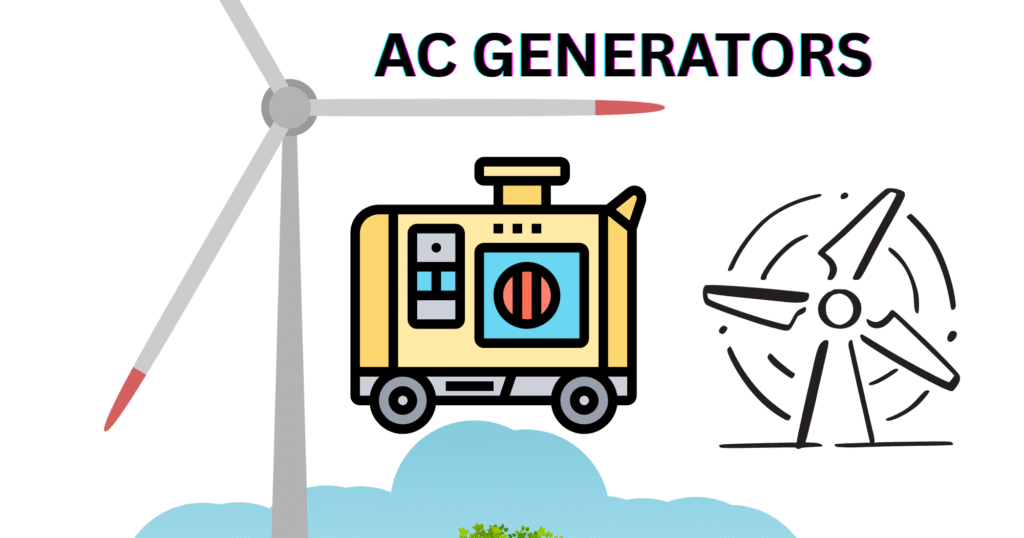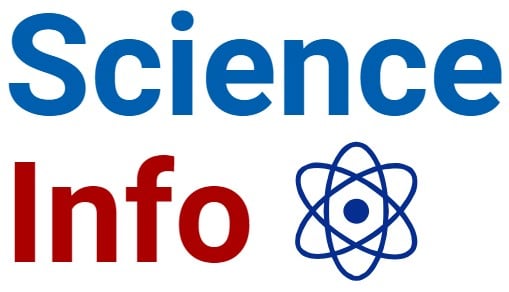Introduction to AC Generators
Unlike a Dynamo, an AC generator is a machine that converts mechanical energy into AC energy. It works on the principle of electromagnetic induction. A conductor moving in a magnetic field experiences an induced electromotive force (EMF). This EMF, when connected in a circuit, gives an alternating current (AC).
AC generators are strong pillars of modern electric systems. A wide range of electricity production systems like power plants and renewable energy sources rely on AC for power generation. AC can be transmitted over long distances with the help of transformers and the voltage can be changed using step up or step down transformers as required. Hence, it has conquered the electricity generation systems.
These days even vehicles, power backup systems, wind turbines, and portable generators use AC generators. Their ability to provide a desirable and reliable AC supply makes them a primary requirement for domestic, commercial, and industrial applications.

Historical Development of AC Generation
Electrostatic generators were developed before the invention of electromagnetic induction. They were operated on the principles of electrostatics. They used the charged belts with moving charges, plates, and disks to carry the charge to a high potential electrode. These generators produced a very high voltage with low current. However, electrostatic generators had low power ratings due to the lack of efficiency and they produced extremely high voltages which were never used to generate power commercially. They were used specially in early X-ray tubes, and particle accelerators.
After the discovery of electromagnetic induction by Michael Faraday in 1831, several power generating systems like dynamo were discovered. One of such systems is the AC generator. In the mid-1800s, the very first generators were designed. Later, a pioneer work was shown by Nikola Tesla in alternating current systems. His discovery of the multiple phase alternating current system in the 1880s made the possibility of effective transmission of power across large distances.
The conflict between Thomas Edison (supporting DC) and Nikola Tesla (Supporting AC) with George Westinghouse (supporting AC) ended with AC proving to be reliable and efficient for large-scale power distribution. By the late 19th century, AC generators had already become necessary in power stations.
Since then, AC generation technology has grown profoundly. Modern generators are larger, more efficient, and may produce thousands of megawatts in power plants. Smaller portable generators and renewable-energy-powered generators are also being used over a huge mass.
Basic Principle of an AC Generator
An AC generator is also an outcome of Faraday’s law of electromagnetic induction. The law is given as: When a conductor is kept near magnetic field lines, an electromotive force (EMF) is induced in it. The magnitude of this EMF is proportional to the rate at which the conductor passes the magnetic flux’.
The induced EMF can be expressed as:
E = NABω sin(ωt) [Equation1]
where,
- N = number of turns of the coil
- A = area of the coil
- B = magnetic flux density
- ω = angular velocity of rotation
- t = time
This sinusoidal variation in induced EMF produces an alternating voltage which gives rise to an alternating current.
Main Parts and Construction of an AC Generator
An AC generator is constructed with the aim of high current generation and hence has to withstand load effects and thermal effects. Thus, it is built to compensate for the undesired effects with its various major parts.
- Stator
It is the stationary part of the generator. It has an armature winding for small machines and the field winding in large devices. It is made up of laminated steel cores so that the eddy current loss is reduced. - Rotor
It is a rotating device of a generator. It is rotated by the field which is powered by DC supply. Induction generators usually have squirrel-cage or wound rotors. - Slip Rings and Brushes
Slip rings transfer AC from the rotors to the external circuit. BBrushes are made of carbon and placed in a sliding contact with slip rings. - Frame and Bearings
The outer frames are designed to provide mechanical support and protection to the system. Bearings help the rotor to rotate smoothly. - Cooling System
The heating effect in the windings and core is controlled by the cooling system. Cooling may be air-based, hydrogen-based, or water-based as required by the machine. - Excitation System
It energizes the system with the DC current and rotates the rotor. Synchronous generators mostly use excitation systems.
Working Mechanism of AC Generators
The working process of an AC generator can be explained as follows:
- Magnetic Flux Interaction
The rotor or the armature rotates inside a magnetic field that is created either by permanent magnets or electromagnets. - Flux Cutting
As the coil rotates, it constantly interacts with the magnetic flux lines. Hence, the flux linkage of the coil keeps varying. - Induced EMF
According to Faraday’s law, a varying EMF is induced in the coil. Its magnitude depends on the speed of rotation and the strength of the magnetic field. - Output Voltage
The induced EMF produces a periodic waveform i.e. positive half cycle as the coil rotates in one direction, and negative half cycle as it rotates in another direction. - Collection of Current
The induced alternating voltage and hence the induced current is supplied to the external load circuit through slip rings and brushes.
This process of continuity produces a constant supply of alternating current as long as the rotor keeps rotating.
Types of AC Generators: Synchronous and Induction
There are mainly two types of AC generators:
- Synchronous Generators
They are generally used in power stations. A uniform magnetic field is generated by the rotor which is powered by DC.
The frequency of the AC produced depends directly on the speed of the rotor:
f = (P × N) / 120, where f = frequency, P = number of poles, N = speed (in RPM)
It is widely used for stable frequency and voltage.
- Induction Generators
It also operates under electromagnetic induction in opposite to the induction motors.
The operation is simple as it does not require separate DC for excitation. In renewable energy systems like wind energy turbines, it can be seen widely. Thus, they are less expensive and reliable. However, they give low efficiency and are harder to control as compared to synchronous ones.
AC Generator Output Characteristics
The performance of an AC generator is described by its output characteristics:
- Voltage: It depends on the excitation, speed, and load.provided to the system.
- Frequency: It is always determined by rotor speed and number of poles.
- Power Factor: It is the ratio of real power to apparent power. It is affected by the nature of the load.
- Load Characteristics: As load increases, terminal voltage falls due to internal impedance and losses.
- Efficiency: It is the ratio output power to mechanical input power which determines how efficiently the input is converted to the output.
To ensure that power systems operate safely and smoothly, these parameters must be kept under the established limits.
Efficiency and Power Losses in AC Generators
Like all machines, AC generators are also not 100% efficient. Power losses in the components of the device reduce their performance. Some common losses in AC generators are as follows:
- Copper Losses (I²R losses)
It occurs in stator and rotor windings due to resistance. The loss rate increases with load current. - Iron Losses
Iron losses are seen in two forms: Hysteresis loss and Eddy current loss. Hysteresis losses are caused by repeated magnetization and demagnetization of the iron core while eddy current losses occur due to the induced currents in the core which create heating. - Mechanical Losses
Friction in bearings and the presence of air resistance in rotors also decreases the efficiency of the system. - Stray Losses
Unlike others, it is a minor loss due to leakage flux and harmonics.
Remedies:
- Using laminated cores to reduce eddy currents.
- Use of high-quality steel can reduce hysteresis.
- Properly lubricating the bearings to reduce friction.
- Use of cooling methods to reduce overheating.
Applications of AC Generators in Daily Life and Industry
AC generators have widespread applications, some of them are given below:
- Domestic Use
There are simple and portable generators suitable for home usage during the power cut period. Small alternators are also used in the bicycles for lighting. - Industrial Use
Large scale power production is required in the industries which is fulfilled by the generators (AC). They are used as the electricity source for factories, refineries, and mines. They are also employed in backup power systems for hospitals, data centers, and airports. - Power Stations
Nuclear power plants, gas plants, thermal and hydroelectric systems all use huge synchronous generators to provide power for the grid. - Transportation
Generators are also used in EVs to charge batteries and also in power onboard electrical systems. - Renewable Energy Systems
Renewable energy sources like wind turbines and small hydroelectric plants use induction or synchronous alternators to rotate the rotors.
Maintenance, Safety, and Troubleshooting of AC Generators
- Maintenance Practices
- Regular checking and inspections of windings and insulation.
- Lubrication of bearings to reduce friction.
- Cleaning of slip rings and brushes.
- Setting proper cooling systems to prevent overheating.
- Regular checking and inspections of windings and insulation.
- Safety Precautions
- Proper earthing and grounding.
- Note the capacity of the system and avoid overload..
- Using protective wears, insulated material like gloves and shields and trained personnels.
- Ensuring safe operating environments to prevent the risk of arc flashes.
- Proper earthing and grounding.
- Common Troubleshooting Issues
- Voltage fluctuations are often seen which can be due to poor excitation or load imbalance.
- Overheating can damage the circuit which is due to overloading, poor cooling methods, or winding failures.
- An unusual noise or vibration can be noticed which can result due to the friction in the bearing failure or rotor imbalance.
- Brush sparking can be caused by the use of damaged brushes or rough slip rings.
- Voltage fluctuations are often seen which can be due to poor excitation or load imbalance.
Future Trends and Innovations in AC Power Generation
- Integration with Renewable Energy: Induction and synchronous generators can be the future of renewable energy with their wide usage in wind, hydro, and biomass plants.
- Smart Grids: Advanced control systems can be built to allow generators to cope with the changing loads and share energy resources.
- Materials and Design Improvements: Superconducting materials can be employed to increase the efficiency in those electric systems. Use of advanced metals and alloys can also help to produce desired output
- Hybrid Systems: Future generators can be thought to combine with solar panels, batteries, and fuel cells for reliable energy solutions.
- Sustained Cooling Systems: Hydrogen and advanced liquid cooling methods can be used for high-capacity machines.
Conclusion
The AC generators are the most important discovery of physics. It has stood a secured position from the primary days to the current days in the application of power generations from small home appliances to large power plants. Their simple construction with minimum maintenance but providing higher voltage transmission and power capacity has replaced DC generators. The larger distance power circulation with minimum energy loss has remained as the best advantage for energy transportation and hence become a backbone of today’s power industries.
REFERENCES
Awarun, O. A., & Aziaka, D. S. (2025). Electrical Power Generator Design: A Review. J Mat Sci Eng Technol, 3(3), 1-7.
Rawlins, C. (2000). Basic AC circuits. Elsevier.
Moyer, E. J., & Chicago, U. (2010). Basics on electricity and electrical generation. The University of Chicago.
Lipo, T. A. (2017). Introduction to AC machine design. John Wiley & Sons.
AC Generator – Principle, Construction, Working, Applications – GeeksforGeeks
byjus.com/physics/ac-generator/
AC Generator: Diagram, Construction, Working, Types, and Uses
